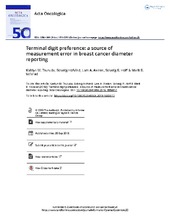Terminal digit preference: a source of measurement error in breast cancer diameter reporting
Peer reviewed, Journal article
Published version

Åpne
Permanent lenke
https://hdl.handle.net/1956/21082Utgivelsesdato
2019Metadata
Vis full innførselSamlinger
Originalversjon
https://doi.org/10.1080/0284186x.2019.1669817Sammendrag
Objectives: Women diagnosed with breast cancer are offered treatment and therapy based on tumor characteristics, including tumor diameter. There is scarce knowledge whether tumor diameter is accurately reported, or whether it is unconsciously rounded to the nearest half-centimeter (terminal digit preference). This study aimed to assess the precision (number of digits) of breast cancer tumor diameters and whether they are affected by terminal digit preference. Furthermore, we aimed to assess the agreement between mammographic and histopathologic tumor diameter measurements. Material and Methods: This national registry study included reported mammographic and registered histopathologic tumor diameter information from the Cancer Registry of Norway for invasive breast cancers diagnosed during 2012–2016. Terminal digit preference was assessed using histograms. Agreement between mammographic and histopathologic measurements was assessed using the intraclass correlation coefficient (ICC) and Bland-Altman plots. Results: Mammographic, histopathologic, or both tumor measurements were available for 7792, 13,541 and 6865 cases, respectively. All mammographic and 97.2% of histopathologic tumor diameters were recorded using whole mm. Terminal digits of zero or five were observed among 38.7% and 34.8% of mammographic and histopathologic measurements, respectively. There was moderate agreement between the two measurement methods (ICC = 0.52, 95% CI: 0.50–0.53). On average, mammographic measurements were 1.26 mm larger (95% limits of agreement: −22.29–24.73) than histopathologic measurements. This difference increased with increasing tumor size. Conclusion: Terminal digit preference was evident among breast cancer tumor diameters in this nationwide study. Further studies are needed to investigate the potential extent of under-staging and under-treatment resulting from this measurement error.
